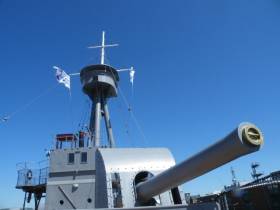Displaying items by tag: HMS Caroline Battle of Jutland 100th
#EnjoyNI2016 – A must see is Belfast’s newest visitor attraction HMS Caroline, a World War 1 light battle cruiser, uniquely the last survivor of the 1916 Battle of Jutland, berthed in the city’s Titantic Quarter, writes Jehan Ashmore.
The slaughter between Britain’s Royal Navy and the Imperial German Navy took place in what was the only major battle at sea of WW1, this involved 250 ships and 100,000 crew. Of course there was the land offensive, notably at the Somme, France, that began a century ago on Friday. This was marked by a major international commemoration ceremony held at Thiepval.
Among those who laid wreaths were president Micheal D. Higgins, UK prime minister, David Cameron and French president, Francois Hollande.
In May the centenary of HMS Caroline’s Jutland role was marked in Belfast and official launch following an extensive £15m plus restoration project. She was one of eight C-class light battle cruisers built in Birkenhead. Since 1924 she has been Belfast based as the Headquarters for the Royal Navy Volunteer Reserve.
Now that she is finally open to visitors, her story reveals one of the greatest naval encounters ever fought and the only clash of battleships and that of rival European powers.
Crews from throughout Ireland served the Royal Navy, they showed extraordinary bravery in not only risking but losing their lives. As visitors, it is a privilege to thread such decks of this unique battle ship, with distinct naval features of that era, the riveted hull and curvature of the bow, the tripod mast complete with look-out.
In addition those three slanting funnels, echoing the classic Transatlantic liners like that of the nearby built Titanic.
By only ‘stepping on board history’ one can begin to experience HMS Caroline as she lies afloat occupying Alexandra Dock. The lock gates of the former dry-dock that fronted onto Belfast Lough rotted away, exposing more of the port when observed at the road entrance to the visitor attraction. The location is also connected by using "The Wee Tram" within Titanic Quarter.
The role she took in the Battle of Jutland saw her among Royal Navy ships such as HMS Dublin and HMS Tipperary engaged in combat with the Germans. The outcome however ultimately led to a huge loss of life. On both sides there were more than 8,600 casualties.
Despite the British claiming victory, they suffered more losses and ships than Germans. The British blockade of Germany continued, this saw severe hardship to the population, that forced Germany into a disastrous submarine campaign which assisted to draw in the USA into the war, and eventually caused a mutiny by disillusioned German sailors in 1918.
The tour of HMS Caroline begins with a wonderful yet impactful film of the battle at sea, that really sets the tone in the dramatic build-up as the 300 crew faced the impending horrors as she entered the theatre of war. Watch the fear of her officers on the the 'open' bridge while also exposed to the natural elements. Directly below is the tiny enclosed bridge in which the self-guided tour features a ‘virtual’ version as part of the exhibits.
HMS Caroline saw action albeit she was only under fire for a mere 12 minutes! , however, the overall battle in the North Atlantic Sea raged for 36 hours. As for weapons, a pair of 6-inch guns are mounted at the bows and where eight 4-inch guns were positioned at the stern.
In close proximity are displayed the torpedoes, noting below decks are hands-on tactile displays involving replicated equipment, that form part of state of the art effects. The combination inter plays with the authentic historic restoration of the structural fabric of the ship.
She was painted in typical naval grey which remains today, though outside of Jutland duties she sported a camoflage effect, for more on this visit the onboard ‘Dazzle Zone’.
Among the interiors are the Captain’s Quarters and Marines Mess. What was notably apparent was that the dining quarters for the captain were only set for one, as the captain dined alone. There is the Signal School where you can try cracking a code using technique of semaphore and flags.
There's also the Sick Bay and Galley and that of ratings quarters be it those accommodated in cabins and that of the humble hammock.
No doubt a draw for many will be the engine rooms, complete with original replication of noise and vibrations, which really adds to the sense of been underway!
I’ve been told that if this was for real, the true level of noise would be closer to twice that experienced! Not to mention the smells and heat generated in what must have been a challenging reality during a time of war.





























































